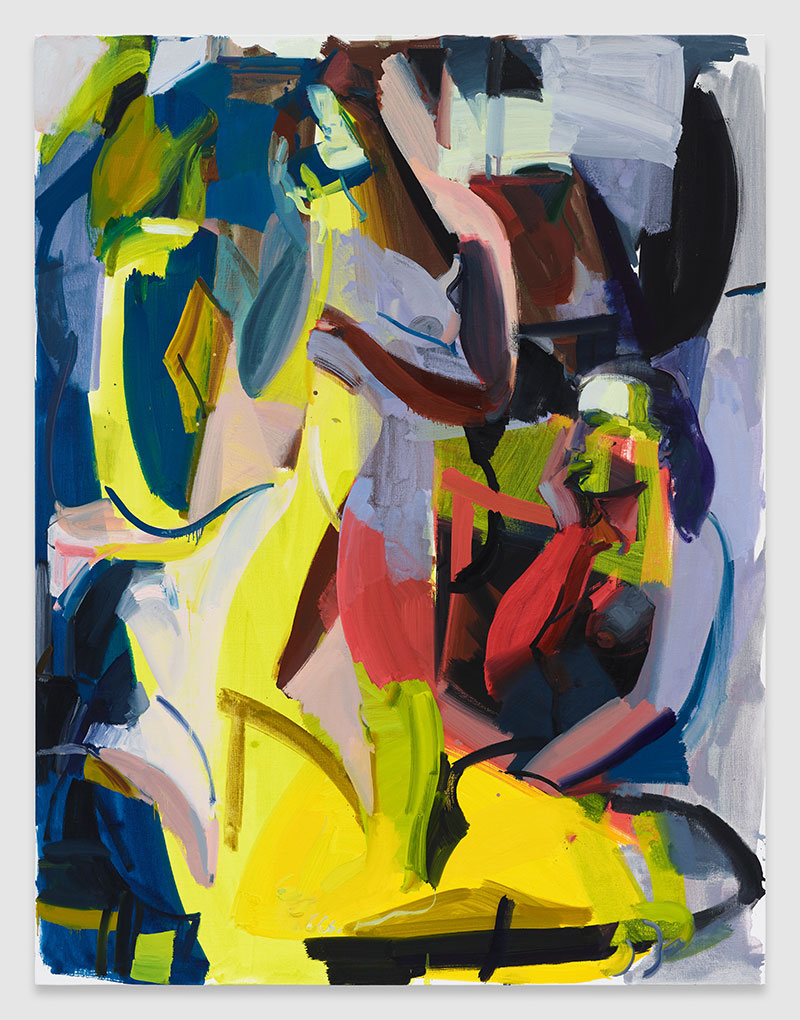The title of Sarah Awad’s recent show seems intended to encapsulate its scope, which is as expansive as the painting from which it’s borrowed. However appropriate it might be for that particular painting, applying it to the exhibition as a whole, though, seems arbitrary and limiting. Even that work itself, Double Field (all works 2018), suggests aspects through which our view might be further expanded and refracted.
Reflection may be implied, as the gallery’s notes suggested, but also simply doubling, shadowing, or even foreshadowing. (Consider the figure in the upper right and its “ghost” limned a few feet opposite.) Although the work’s willful abstraction would seem to preclude a narrative address, Awad does not shy away from the psychological or the temporal dimensions of the work. The fractured composition is echoed by its discrete durational zones. It’s less about reflection than multiple-exposure—a temporal as well as spatial superimposition.
Everything All At Once might serve as a kind of index to Awad’s means of abstraction—from its primary-dominant palette which nevertheless didn’t shy from the monochromatic to the melding of figurative elements into an alternately dense or thinly abstracted mass. In other words, Awad was willing to subordinate layered, figurative, incidental, ghosted or merged human body parts to the composition as a whole. The sharply articulated or delineated coexisted side-by-side with the densely abstracted or even obliterated. Here the sense of doubling or reflection seemed to carry a clear time signature: the “sustained” figure (violet-brown face, green nose), interrupted (split-face) or followed by two further abstracted or even ‘faded’ figurative elements (blue; then pale yet distinct—all submerged into the mass); the surface incident supported by dense undercurrents of subordinated and entirely abstracted figuration.
Sense and sensuality are abundantly referenced, however faded or submerged. The central figure in Liz Caught in the Act might be reaching, grasping, or more specifically grooming or gesturing. These are bodies that relate to themselves and others, but also to past incidents or incarnations. The figures in Night Swim are lost in dense sapphire and indigo that is in the lower emptied-out quadrant of the canvas. A figure may push forward from its abstracted ground to boldly assert a geometric contour—e.g., the sharply delineated crescent of cantaloupe cleavage in Derriére. Within the compass of her aggressive abstraction, Awad is not hesitant to invoke the classical figure in these paintings, which underscores their deep reference (if not reverence) to the past.
This is the central tension of the work—between reflection and transparency, social and solitary relations; with every element working in concert, yet as if in a kind of absence of unitary consciousness. However distinct her signature, Awad seems prepared to set her own authorship to one side. Beyond classicism, they invoke a view of the cosmos, from which the fulcrum at the center of these mechanisms may be allowed to vanish.












0 Comments